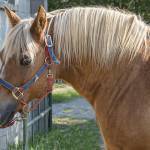Back to Basics: Studying Canagliflozin in Horses for Treating Insulin Dysregulation

For some horses and ponies with insulin dysregulation and laminitis, the sodium-glucose co-transporter-2 inhibitors (SGLT2is) can be life-saving medications. Because of the demand for these drugs, veterinarians are prescribing them in the face of limited clinical studies and without any basic pharmacokinetic data. Looking to fill the gaps in knowledge on how SGLT2is are absorbed, distributed, metabolized, and excreted, researchers returned to the basics and studied canagliflozin, a common SGLT2i, in healthy horses.
In the study, eight healthy Icelandic horses were administered a single oral dose of 1.8 mg/kg canagliflozin mixed with soaked alfalfa pellets. Blood was subsequently collected to measure canagliflozin levels and various pharmacokinetic parameters.*
“After a single dose of canagliflozin, time to peak drug concentration in the blood was 7 hours. The half-life, a measure of drug elimination, was 28.5 hours, but two horses had prolonged half-lives at 39 and 42 hours,” shared Ashley Fowler, Ph.D., a nutritionist for Kentucky Equine Research.
The fact that the half-life can be prolonged raises concern for potential drug accumulation and toxicity in some horses. Further pharmacokinetic studies are needed using different drug concentrations in both healthy and diseased horse populations. Long-term effects also need to be evaluated.
In this study, a dose of 1.8 mg/kg was selected, but doses typically prescribed to horses in the field are usually much lower at 0.3 to 0.6 mg/kg. No adverse reactions were observed in these eight healthy horses, even at the higher dose, confirming previous reports that SGLT2is appear safe in horses.
“Despite the positive results in this study, SGLT2is should not be the first or only tool owners reach for when their horse is diagnosed with insulin dysregulation,” Fowler cautioned.
Instead, Fowler recommended maintaining a healthy body condition score through diet and exercise.
“Owners are encouraged to feed hay that contains low nonstructural carbohydrates and restrict hay intake to encourage weight loss. Pasture access should also be restricted or eliminated as pasture grass often has greater nonstructural carbohydrate content than many hays. Finally, feeding a source of DHA and EPA, such as fish oil, may help improve glucose tolerance,” she said. “Choose EO-3 as a proven source of DHA and EPA.”
*Michanek, P., J. Bröjer, I. Lilliehöök, C.T. Fjordbakk, M. Löwgren, M. Hedeland, J. Bergquist, and C. Ekstrand. 2024. Pharmacokinetics and alterations in glucose and insulin levels after a single dose of canagliflozin in healthy Icelandic horses. Journal of Veterinary Pharmacology and Therapeutics: 13476.








